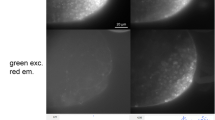Summary
Fluorescence spectra of leukocytes stained by both mithramycin and DAPI showed that the fluorescence of the two dyes can be separated efficiently by using different excitation wavelengths, for instance the 435 nm and the 365 nm mercury lines. In human chromosomes the complementary (“reverse”) banding pattern produced by these dyes may thus be observed on double stained chromosome spreads. In plants, for instance in Anemone blanda, the two dyes may reveal two different banding patterns. The results of absorption and fluorescence measurements suggest the existence of at least two binding sites, or types, for each dye, with different fluorescent yields and binding strengths.
Similar content being viewed by others
References
Bontemps, J., Houssier, C., Fredericq, E.: Physico-chemical study of “33 258 Hoechst” with DNA and nucleohistone. Nucleic Acid Res. 2, 971–984 (1975)
Goldberg, I.H., Friedman, P.A.: Antibiotics and nucleic acids. Ann. Rev. Biochem. 40, 775–810 (1971)
Johannisson, E., Thorell, B.: Mithramycin fluorescence for quantitative determination of DNA in single cells. J. histochem. cytochem. 25, 122–128 (1977)
Keller, R., Bregnard, A., Gehring, W.J., Schroeder, H.E.: Morphologic and molecular changes in target cells during in vitro interaction with macrophages. Exp. Cell Biol. 44, 108–124 (1976)
Lin, M.S., Comings, D.E., Alfi, O.S.: Optical studies of the interaction of 4′,6-Diamidino-2-phenylindole with DNA and metaphase chromosomes. Chromosoma (Berlin) 60, 15–25 (1977)
Rigler, R.: Interactions between Acridines and DNA. In: Chromosome identification. Nobel Symposia, Caspersson T., Zech L. (eds.), p. 335–341. New York: Academic Press 1973
Schnedl, W., Breitenbach, M., Mikelsaar, A.-V., Stranzinger, G.: Mithramycin and DIPI: a pair of fluorochromes specific for GC- and AT-rich DNA respectively. Hum. Genet. 36, 299–305 (1977a)
Schnedl, W., Roscher, U., Van der Ploeg, M., Dann, O.: Cytofluorometric analysis of nuclei and chromosomes by DIPI staining. Cytobiologie 15, 357–362 (1977b)
Schweizer, D.: Reverse fluorescent chromosome banding with chromomycin and DAPI. Chromosoma (Berlin) 58, 307–324 (1976)
Schweizer, D., Ambros, P., Andrle, M.: Modification of DAPI banding on human chromosomes by prestaining with a DNA-binding antibiotic, Distamycin A. Exp. Cell Res. 111, 327–332 (1978)
Author information
Authors and Affiliations
Rights and permissions
About this article
Cite this article
Leemann, U., Ruch, F. Selective excitation of mithramycin or DAPI fluorescence on double-stained cell nuclei and chromosomes. Histochemistry 58, 329–334 (1978). https://doi.org/10.1007/BF00495389
Received:
Issue Date:
DOI: https://doi.org/10.1007/BF00495389




